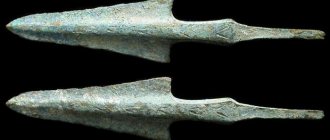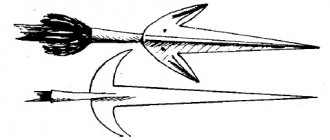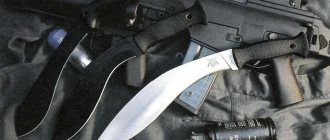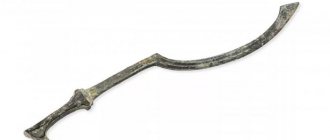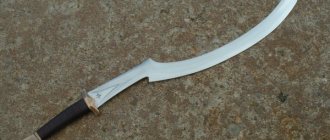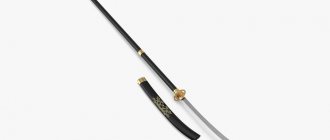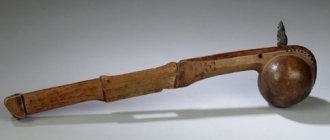Signs of a bladed weapon are a blade larger than 9 cm, a handle from 7 cm, a spine thickness of 2.5-6 mm, steel hardness from 42 HRC, a type of handle with protection from injury, a sharpened blade, a point up to 70 degrees.
Hunting, military, and sports products may fall under this category. And not only knives, but also daggers, stilettos, dirks, axes. Then the owner will need permission to carry, as will those for whom such a weapon is part of the national costume or a reward for service.
Signs of edged weapons and parameters: 5 main components
The signs of a real edged weapon are all its physical parameters considered together, that is, the overall size, the length of the blade and handle, the thickness of the blunt edge of the main part, the quality of the steel, and the features of the handle from the point of view of convenience and safety. They are specified in GOST, as well as federal law, and the requirements apply to both factory-made and handicraft products. 5 signs of edged weapons are:
| Parameter | Its meaning or presence |
| Blade length | More than 9 cm |
| Butt thickness | 2.5-6 mm |
| Hardness of the steel from which the blade is made | From 42 HRC |
| Recesses on the handle for a comfortable grip | Depth from 4 mm |
| One notch on the handle or finger stop | Depth from 5 mm |
| Sharpened Blade | Eat |
It is possible to establish that a knife has non-domestic use, is not a sports equipment or a production device, if all the above conditions are simultaneously present. But sometimes it is possible to identify edged weapons only after an examination. And when doing this, the sharpness of the blade, for example, is very controversial, because it can be recognized as sharpened even if it only cuts paper.
In general, among all the components, the most important thing is the features of the blade. A product cannot be considered a weapon if it has:
- The tip is rounded or designed for performing household work (such as a screwdriver). It is difficult for them to stab, so the knife is not recognized as a bladed weapon.
- The tip is 5 mm above the butt line. In these cases, stabbing is also problematic.
- The butt has a deflection of 5 mm, and the length is up to 180 mm. Or the first indicator is 10 mm, and the second is from 180 mm. And here the thrusting blow is poorly executed.
- There is a hook at a distance of 1/3 of the length of the blade from the tip. This happens with hunting knives that are not edged weapons.
- The butt and the part of the handle closest to the blade are curved upward by more than 15 mm. And this prevents the knife from being stabbed.
- The lines of the blade and butt form an angle of more than 70 degrees. This also makes it difficult to thrust.
- The handle is less than 70 mm, it has grooves up to 4 mm deep or there are none at all, as well as a limiter. With such initial data, the knife is dangerous for the piercer, that is, it is not intended to kill.
Blade length, thickness
The length of the knife blade, which is a weapon of destruction, is more than 9 cm. It should be measured from the tip to the point of connection with the handle or limiter. But many kitchen products have this length; nevertheless, they are allowed and sold freely. That is, this value in itself is not yet a sign of a prohibited weapon; for example, the thickness of the blade also matters. This is the sharpness of the blade and butt, which will be discussed further.
Blade length
The length of the blade of a knife that is prohibited from being owned without a license is not regulated by GOST. When they mention it, they mean the size of the blade, although this is not exactly the same thing:
- it is measured from the tip of the tip to the beginning of the handle (for edged weapons more than 9 cm);
- The size of the blade is determined by the sharpened edge of the blade.
But to determine the type of weapon, the parameter does not matter.
Butt thickness
The thickness of the butt, which is prohibited for free purchase of the product, is 2.6-6 mm in the most massive part. If it is less than the minimum value, it is considered that the blade will bend upon impact. And with a thickness of 6 mm or more, sticking it into the body is also problematic, that is, the penetrating ability is lower. Although in fact both statements are controversial. And yet, approved knives usually have a spine no more than 2.4 mm thick.
Confinement
The sharpness of the blade of the cold tool is such that it should be able to cut a birch branch with a thickness of 10-12 mm and 12% humidity in 5 movements. Moreover, the surface of the exposed area of the stick should be smooth, without “burrs.” This condition is specified in GOST.
Anatomy of a blade: a clear understanding of what descents, approaches and cutting edges are
Hardness
The blade steel of a melee weapon must be from 42 HRC. Anything less than this value will bend upon impact, meaning it will not be possible to fully strike with it. This criterion is also defined by the state standard.
Checker
At one time, this weapon was glorified in Cossack songs and stories, and depending on the purpose of the checker, there were several different types of this weapon, popular in Russia. A standard saber had one blade and a length of no more than one meter. The blade was slightly bent and sharpened in different ways. Circassian checkers were lighter and allowed more maneuvers in battle due to their small size.
Cold steel: definition according to Russian law
The definition of what a cold weapon is, according to the law of the Russian Federation, is as follows:
“Melee weapons are weapons designed to hit a target using human muscle power in direct contact with the target;”
It is in Article 1 of legal document No. 150-FZ dated December 13, 1996, which is still valid in 2022. More information about what types of knives fall into the category of edged weapons is available in GOST R 51500-99 and R 51548-2000.
GOST for manufacturing
GOST R 51500-99 prescribes what a hunting edged weapon should be. More precisely, in accordance with the document, the belonging of knives to this category is established by expert means. We are talking about the length of the blade, the sharpness of the blade, the ergonomics of the handle, that is, all the previously mentioned characteristics.
GOST R 51548-2000 regulates the design features of survival knives and applies not only to them, but also to homemade tools. It also indicates which of these types are not edged weapons (blade up to 9 cm inclusive, butt thickness up to 2.6 mm, steel hardness up to 42 units, etc.).
When determining whether a knife belongs to the category of edged weapons, the requirements of the standards and Federal Law No. 150 of 1996 are compared.
Watch the video about the signs of edged weapons:
Cestus
0
Boxing in Rome was often deadly, as Roman boxers wore a cestus on their hands. This was a type of glove that was most often made from leather strips coated with metal. Although gladiators often fought to the death, fighters would sometimes give up and even agree to a brief truce to rest. Roman boxing was a very cruel sport, even the winner was often left mutilated.
Types of bladed weapons
There are the following types of the most common edged weapons:
- chopping (axes of various types);
- sports (knives, rapiers, swords, etc.);
- hunting (horns, knives, cutlasses, stilettos, etc.);
- combat (bayonet-knives, daggers, etc.).
Slashing
A chopping weapon that falls under Federal Law No. 150-FZ of 1996 is any type of battle ax:
- bearded,
- labrys,
- tomahawk,
- berdysh,
- valashka,
- minted
This category also includes cutting and piercing cleaver, saber, broadsword, saber, dagger, axe, and sword. As well as the less common halberd, machete, kukri, scimitar. Any type of product must have a sharpened blade, otherwise it can be legally owned without a license and without fear of a fine. Collectors, those involved in military reenactments, may own any of these types of weapons, as long as the blade is dull.
Sports
Sporting weapons prohibited in the public domain are:
- sword,
- a spear,
- rapier,
- saber,
- sword,
- throwing knives.
We are talking about specimens that have the characteristics inherent in bladed weapons. For example, swords and rapiers that athletes use in training and competitions are not such. Like throwing knives sold in stores, their blade is not sharpened; only the upper third of the blade remains sharp.
Hunting
A hunting weapon is considered cold if it is:
- dagger,
- stylet,
- cleaver,
- spear,
- a spear,
- knife.
Rogatina is a Slavic heavy spear for hand-to-hand combat or for hunting large animals.
But only when they have a blade length of 90 mm, the blade is sharpened (especially on both sides), the handle is 70 mm in size and protects against injury during a piercing blow, thickness butt is more than 2.6 mm, but less than 6 mm.
Combat
Military weapons are divided into:
- made for military and paramilitary forces (knives, bayonets, daggers);
- police officers (these include not only instruments with blades, but also batons and tonfa);
- civilian (which is part of the national costume, for example, among Caucasians and northern peoples).
All of the above can be classified as cold steel if the previously mentioned signs are present. In the absence of at least one of them, the examination recognizes the item as authorized for possession and wearing. For example, if the knife looks like a military knife, but it has a dull blade, or it is less than 9 cm.
Combined
A combined weapon is something that combines several varieties:
- firearms and piercing objects (for example, rifles with bayonets);
- a multifunctional product that, in addition to the blade, contains a working tool;
- a weapon with a secret, when another is hidden in one object (a dagger in the handle of a mace or a pike in a sword).
The criteria for classification as a prohibited species are the same as in previous cases. But due to the complexity of the product design, they are not so obvious and sometimes assessment is difficult without an examination.
Rifle with bayonet
Pros and cons
So, are “cold” knives the most adequate option when choosing? Certainly not. The best knives that we can choose for ourselves will almost never be like this. The main criterion here is not only the scope of tasks, but also legal restrictions on the carrying and circulation of bladed weapons. If household knives have no restrictions on use and purchase, then in the case of edged weapons you should be careful. But then, secondly, we determine what the knife will be used for. And here sometimes compromises are impossible. For example, what knives should perform the function of finishing off an animal during a hunt leaves us with no choice but to turn to extremely effective edged weapons. And some restrictions on its free carrying or acquisition should not repel us, but once again remind us that handling weapons implies responsibility.
Classification of edged weapons
The classification of different types of edged weapons can be:
- For the intended purpose. Products can be civilian, that is, used to perform some kind of work, or combat. The first type includes sports, hunting tools, and also those that are part of national clothing.
- According to the manufacturing method. Products can be factory-made, artisanal, homemade or redesigned. The first two types differ in compliance with standards. Homemade is done by non-specialists, unlike artisanal. And the converted one lacks required elements or new ones can be added.
- According to the principle of operation. These are piercing, cutting, chopping, crushing, piercing-cutting (combined) instruments. With this classification, the criteria for edged weapons are sometimes quite vague. After all, with the same tool you can prick, cut, and chop.
- By type of impact. It can be bladed or thrown. The first involves direct contact with the enemy when causing damage. Throwing weapons for the same purpose are thrown from a certain distance.
- According to design features. Products are available with one or two blades.
The characteristics of edged weapons, even within the same type, may differ. For example, throwing a knife and a spear are considered sports. But there is an obvious difference between them.
What does cold stabbing refer to?
Specialists consider the following types of cold stabbing weapons:
- knife,
- dirk,
- pike,
- kris (national type of dagger with a curved shape),
- a spear,
- konchar (ancient Russian tetrahedral blade),
- stylet,
- bayonet,
- spear,
- rapier,
- sarissa (long spear).
Stiletto - cold piercing weapon
Any of these instruments is designed to deliver piercing blows rather than cutting or slashing. To recognize a weapon as cold, the same characteristics must be present as when assessing another type.
What can a combat knife be used for?
A modern combat knife is not only a weapon, but also a tool designed to perform various tasks. As experience shows, most often a soldier needs a knife not to wound or kill an enemy, but for more prosaic operations.
Firing position equipment. This is the most important task in a combat situation, which must be performed competently and as quickly as possible. Using a tactical knife, you can quickly remove various obstacles that block the shooting sector or block your view. These could be branches, curtains, awnings. A fighter can also use a knife when digging, but for this the strength of the blade must be high.
Release in extreme situations. During combat operations, a fighter may become entangled in ropes or cables; in such cases, his life depends on the knife. This can happen when descending from the wall of a house, from a helicopter, or during an airdrop.
Release from handcuffs. In recent years, not metal handcuffs, but those made of plastic are increasingly being used. They are usually cut using wire cutters. A good knife will also cope with this obstacle; knives with a wave sharpening are especially suitable.
Removing obstacles underwater. A good knife is very often a matter of life or death for members of special naval units. For underwater saboteurs and divers, fishing nets are one of the most dangerous threats. A knife can easily solve this problem, saving a person’s life.
Interesting edged weapons of the world
Noteworthy edged weapons in the world are:
- Russian combat knives Gyurza, Lynx, Punisher, Vityaz, Antiterror, Akela, Shaitan;
- foreign-made military products Ka Bar Next Generation Fighter, Eickhorn Kampfmesser 2000, Extrema Ratio Fulcrum S, etc.;
- tools of ancient times Santesu, Klinga, Chakram, Katar, Khopesh, Cho-ko-nu, Odati, etc.
Best Contemporary
The best modern edged weapons belong to the category of combat weapons, and among Russian ones these are knives:
| Knife name | Description | Photo |
| Lynx | Created in Zlatoust, having a dagger-shaped blade. | |
| chastener | Made by order of the special services, it has a serrated blade sharpening and a wide main part. | |
| Knight | With a massive and heavy, but not wide blade. | |
| Anti-terror | Characterized by a serrated edge of the butt and a sharp blade. | |
| Shaitan | With a leaf-shaped blade and double sharpening. | |
| Akela | With a narrow dagger-like main part and a sharp butt. | |
| Gyurza | Characterized by double sharpening and a jagged spine. | |
| Cobra | It has a narrow double-sided blade and therefore works well when delivering not only piercing, but also cutting blows. | |
| Werewolf | A folding knife that is both combat and survival, as it has a blade, 2 saws, a nail puller, an opener, and a screwdriver. |
Among the foreign-made guns, the best are:
- the American Ka Bar Next Generation Fighter, which has a wide blade with a one-sided sharpening;
- also an American Camillus Jet Pilots Survival Knife, designed not only for combat, but also for survival in difficult conditions;
- another American Ontario Mk.3 Mod.0 Navy Seal Knife, which can be used as a saw, hammer, but mainly for stabbing;
- German Eickhorn Kampfmesser 2000, distinguished by a unique blade shape, similar to Japanese knives, as well as large slopes, serrated sharpening on a third of the blade;
- Italian Extrema Ratio Fulcrum S, which is convenient for stabbing, cutting and chopping thanks to a narrow but powerful double-sided serrated blade;
- CQD Mark V ATAC, which is a dagger with a 2/3 sharpened butt, which will also help for survival.
Watch the video about the 10 best knives of foreign origin:
Rare
Rare weapons classified as cold steel are mainly antique or national types of knives:
- Japanese Santesu, which is a double-edged lance with a ring handle attached to the center;
- Nubian Klinga, which has 3 blades;
- Indian Chakram - a throwing ring with a wavy handle in the middle;
- the Aztec Macuahutl, which is a wooden blade to which sharp glass was attached;
- Indian dagger Qatar with three blades fixed to an H-shaped handle;
- Egyptian Khopesh, which is a sickle with a wooden handle;
- The Chinese Cho-ko-nu is a wooden crossbow that works in such a way that you can load an arrow, pull the string and shoot in one motion.
Chinese Cho-ko-nu Indian knife Chakram Nubian knife Kling Egyptian sickle sword Khopesh
Among all the swords that deserve special attention: Japanese Naginata and Odachi, ancient Greek Xiphos, ancient Roman Gladius, Scythian Mitsiya, as well as ancient Russian ones.
Santensu
0
A simple but effective weapon used by samurai, the santensu was a pocket-sized iron rod that usually had a ring attached to the center. The middle finger was inserted into the ring, and the rod was squeezed in the palm. Perhaps because of its simplicity, santensu was easily adaptable to a specific user. The ring could be equipped with spikes to add additional damaging power to the blow. Some santensus were equipped with long spikes instead of rings for this purpose. Such santens were used for killing rather than for self-defense.
How to carry a bladed weapon
You can carry bladed weapons only if you have a license for it, which is obtained from the police. Ordinary citizens have access to the legal purchase of hunting blades, as well as products that are an attribute of the national costume (sabers, knives, checkers, daggers). Award weapons can also be owned, but not inherited, given away or sold.
It should be worn:
- be safe, that is, the product should be hidden in a case or sheath;
- be supplemented by the presence of a permit (hunting ticket with a mark, license), as well as the owner’s passport.
You cannot take tools with you to public events, cultural or political, if they are not related to the demonstration of products.
Gadling
0
Anyone who was interested in the weapons of European knights probably paid attention to their armored gloves. While the main purpose of gloves was to protect the hand, glove makers couldn't pass up the chance to use them as brass knuckles. In the late 14th century, gunsmiths began attaching metal studs and spikes, called gadlings, to the knuckles of knights' gauntlets. This was essentially the weapon of last resort if the knight’s sword was suddenly knocked out.
FAQ
What is the history of edged weapons?
It appeared as a hunting one, that is, almost simultaneously with humans. At first these were clubs and clubs with fragments of stone, then flint knives. When copper was discovered, swords, arrowheads and spears appeared, then bronze tools. Under the Roman Empire, iron swords began to be made, and later sabers. Later, polearms and throwing weapons (spears, halberds, knives, darts, axes) appeared.
Why are edged weapons called edged weapons?
It differs from “hot”, that is, fire, in that use is not caused and is not accompanied by the release of heat or combustion of any substances.
Is a folding knife a bladed weapon?
Yes, if its blade is more than 9 cm, the handle is protected from injury and longer than 7 cm, the blade is sharpened, the tip is not rounded, and the thickness of the blade is 2.6-6 mm. No, when the knife parameters do not correspond to those specified. The fact that a weapon folds does not make it prohibited.
Can I carry a knife with me?
Yes, if it does not meet the criteria for edged weapons.
Is a machete a bladed weapon?
No, if it has a certificate that it is a household tool. Yes, when the technical characteristics of the product correspond to edged weapons.
How to distinguish a bladed weapon from a simple knife?
Take your own measurements or submit them for examination.
Is a kitchen knife a bladed weapon?
No, this is a household product.
Is kukri a bladed weapon in Russia?
Most often, no, this is a household appliance. But you need to look at the characteristics and compliance of the kukri with the requirements for approved knives.
What knives are considered civilian edged weapons?
In accordance with Article 3 of the Law “On Weapons” this is:
- bladed and throwing, used for sporting and hunting purposes;
- Cossack checkers, sabers and other types belonging to national cultures (they are worn with costumes);
- antique knives, their replicas and copies, products of cultural value.
What edged weapons are prohibited in Russia?
Flails, brass knuckles, boomerangs, shurikens and other shock-crushing and throwing products, if they do not have cultural and scientific value, are not sports equipment.
Is an ax a bladed weapon in Russia?
Ordinary - no, this is a household or industrial tool, about which there is information in the certificate for it.
Is the manufacture of bladed weapons allowed?
No, there is clause 4 of Article 223 of the Criminal Code of the Russian Federation, which prohibits this and regulates penalties for craftsmen.
We recommend reading the article on types of knives. From it you will learn about the basic shapes of knives, their names and characteristics, the materials of the knife blade by type of metal, as well as the rules and criteria for choosing a knife. Find out more about the best switchblades here.
Even a kitchen knife and a pocket knife can become dangerous, but this does not negate the threats that real edged weapons pose. Therefore, amateurs and collectors of such items should order an examination of the product before purchasing. And if it is recognized as a weapon, stock up on a license to own it.
Tiger Claw Bagh Nakh
0
The Bagh Nakh was a symbolic weapon, not a lethal one. It was common in the Mysore region of India in the 1700s, where a supreme goddess was worshiped in the form of a tiger. The Bagh Nakh, which literally translates to “tiger claws,” consisted of four to five pointed, curved blades attached to a crossbar. Such weapons tore skin and muscles like a blow from a tiger's paw.

